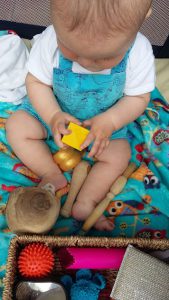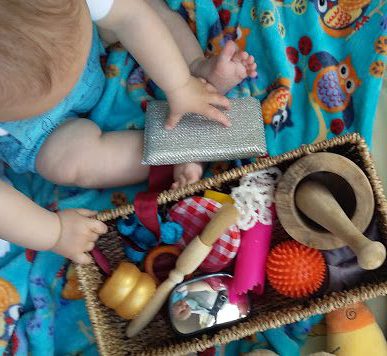10 ways to promote your child’s learning without spending a penny! #1
Number 1: Make a treasure basket!
 Your little ones learn best by exploring with all their senses; and a treasure basket provides the perfect FREE way to introduce them to loads of new shapes, colours, smells, sounds and textures all in one place. This is part of a concept known as ‘heuristic play’, a term coined by leading child psychologist Elinor Goldschmeid in the early 1980’s and describes the activity of babies and children as they play with and explore the properties of ‘objects’ from the real world. Babies, she wrote in 1989, “suck, grasp, touch and feel objects, [rehearsing] behaviours which foster their earliest learning”.
Your little ones learn best by exploring with all their senses; and a treasure basket provides the perfect FREE way to introduce them to loads of new shapes, colours, smells, sounds and textures all in one place. This is part of a concept known as ‘heuristic play’, a term coined by leading child psychologist Elinor Goldschmeid in the early 1980’s and describes the activity of babies and children as they play with and explore the properties of ‘objects’ from the real world. Babies, she wrote in 1989, “suck, grasp, touch and feel objects, [rehearsing] behaviours which foster their earliest learning”.
What is it?
If you’re still wondering what I’m talking about, a Treasure Basket is basically a ‘basket’ containing a small collection of ‘real’ natural and household objects for a child to investigate and play with. The use of real objects instead of toys means that play can be entirely open-ended, with no ‘rules’ or pre-conceived ideas about how to play. Children and babies can focus entirely on discovering the different properties of each object, rather than what it is ‘for’. The inclusion of natural objects such as a shell, a feather, a stone or a pine cone will also give your baby a safe way in which to begin to explore the natural world.
What do I do with it?
Collections of objects in treasure baskets can be brilliant with children of all ages to promote their sensory development, but they really come into their own when used with babies who are not yet mobile. It can often be the first time that a baby gets to really ‘choose’ for themselves what they play with, how long they play with it and what they do with it. It is for this reason that it’s important to allow your child to ‘lead’ their own play. Now is not the time to talk and ask questions but the time to sit back (preferably with a cup of tea!) and watch what your child does. See what they pick up, what they spend most time with, what they do with each object. This will give you a real insight into your little one’s thinking and what excites and interests them, as well as giving them the freedom to quietly explore and experiment in their own time. Try to interact with them on their terms, smiling back when they make eye contact, answering softly when they ‘speak’ to you, looking at objects that they offer you, but being careful not to distract them from what they are doing until you see that they have lost interest themselves. Some babies and young children will play immersed for long periods (my daughter), while others (like Reuben!) may prefer to dip in and out for shorter periods, or may want more interaction with you while they play. Try offering your child the basket at different times of day, and in different places, to find out what they like best, and build it up slowly if your child seems reluctant at first.
How do I make it?
Start by finding your ‘basket’. This does not have to be an actual basket (although a natural woven basket provides it’s own textures to explore!) but can be any stable receptacle with low sides that your baby can easily reach into. The basket in the picture was a cheap storage basket that I had in the house but anything shallow enough will do. Although my basket is rectangular, rounded shapes do lend themselves better to fitting comfortably between baby’s legs. If you don’t have a suitable receptacle most supermarkets and garden centres often have good shallow storage baskets, and charity shops are also a good place to look. My son has had themed baskets in a wooden fruit bowl, a metal mixing bowl and a large biscuit tin among other things!
Next, go around your house and garden finding objects that your child might find interesting. Don’t worry too much about safety at this stage but concentrate on finding as many smallish things from around your house (or garden) as you can! It helps to try and see things with your child’s eyes and think about how something looks, feels, smells etc. rather than focusing on what it actually is. Does it make a sound? Does it have an interesting texture? Does your child show an interest in it?!
Your next job is to go through your collection and consider each item for safety. You should always supervise your child when playing with any objects that are not specifically designed for the purpose, so you are just removing any that you would not be happy for your child to play with in your presence. Does it have small parts that could easily come off? (remember a baby can choke on an object the size of a peanut). Does it have flaking paint or coatings that could be toxic if licked? Does it have sharp edges that could cut or hurt your child? (I always test on my finger if I’m not sure!).
Make a little collection from what you have left, trying to create a good mix, and arrange them appealingly in your basket. You could include including something soft, something smooth, something prickly, something that rattles, something with holes, something that fits inside something else, something that has a smell…try hard to include a mix of natural and household objects where possible. Stick to a small group of objects to begin with and any remaining items can be put away safely for now. As you notice your child losing interest in an object (usually after a few play sessions) you can then swap it for something new the next time you give them the basket!
 The basket Reuben is playing with here contained:
The basket Reuben is playing with here contained:
- a wooden pestle and mortar
- a spiky pilates ball
- a crochet woollen flower
- a stretch of ribbon
- a small plastic mirror (from the car)
- a silicone garlic skinner
- a scouring pad
- a wooden pastry brush
- a painted wooden brick that rattles
- a curtain ring
- some fluffy wool
- a piece of satin fabric
- a washing machine dosing ball
- a smooth rock
Beware of too much plastic!
This is not just because plastics containing PVC, Phthalates and BPA are known to leach harmful chemicals, although this should definitely also be a consideration, particularly as your baby will probably put these objects into their mouth. From a purely learning point of view, however, most plastics offer very limited sensory stimulation, particularly when you consider the subtle range of textures, smells and tastes that your child will experience from most naturally sourced materials, so should be used in limitation. Better to focus mainly on objects made of rubber, silicone, safe metals, wood, paper, fabrics, glass (ensure it’s strong enough!) etc. You can also use the link above to find information that will help you to identify the safest plastics to use.
What next?
Once you and your child have started to play with treasure baskets you may choose to develop their play even more by creating baskets with a particular theme! Ideas you could use might be ‘shiny things’, ‘fabrics’, ‘noisy things’, ‘things that are spherical’, ‘wooden things’…I’d love to hear about your own ideas!
Have fun, and please do get in touch with pictures and stories about what you have tried! I am able to provide lists of objects on request, and am planning to begin selling my own themed baskets via this website in the future. Be the first to know and sign up to this blog to receive regular updates as they happen!


Leave a Reply
You must be logged in to post a comment.